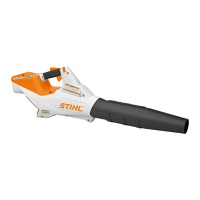0458-824-8621-B
9
English
5 IMPORTANT SAFETY INSTRUCTIONS
5.6.3 Working Conditions
WARNING
■ Operate your blower only under good visibility during
favorable daylight conditions.
– Postpone the work if the weather is windy, foggy,
rainy or inclement.
■ Your blower is a one-person machine.
– Bystanders, especially children, and animals should
not be allowed in the area where it is in use.
– Switch off the blower immediately if you are
approached.
■ To reduce the risk of injury to bystanders and
unauthorized users:
– Never leave the blower unattended when the battery
is inserted.
– Switch off the blower and remove the battery during
work breaks and any other time the blower is not in
use.
■ Operating the blower in certain dry, dusty conditions may
cause static electricity to build up in the blower tube,
nozzle and housing. This static electricity may discharge
suddenly with a spark. To reduce the risk of personal
injury following static discharge:
– Never operate the blower in a location where
combustible gases, liquids, vapors, dusts or other
combustible materials and substances are present.
■ Sparks generated from operation of the blower may be
capable of igniting combustible gases, liquids, vapors,
dusts or other combustible materials and substances. To
reduce the risk of fire and explosion:
– Never operate the blower in a location where
combustible gases, liquids, vapors, dusts or other
combustible materials and substances are present.
– Read and follow recommendations issued by
government authorities (e.g., OSHA) for identifying
and avoiding the hazards of combustible gases,
liquids, vapors, dusts or other combustible materials
and substances.
■ Use of this blower can generate dust and other
substances containing chemicals known to cause
respiratory problems, cancer, birth defects and other
reproductive harm.
– Consult governmental agencies such as EPA,
OSHA, CARB and NIOSH and other authoritative
sources on hazardous materials if you are unfamiliar
with the risks associated with the particular
substances with which you are working.
■ Inhalation of certain dusts, especially organic dusts such
as mold or pollen, can cause susceptible persons to have
an allergic or asthmatic reaction. Substantial or repeated
inhalation of dust or other airborne contaminants,
especially those with a smaller particle size, may cause
respiratory or other illnesses.
– Control dust at the source where possible.
– To the extent possible, operate the blower so that
the wind or operating process directs any dust, mist
or other particulate matter raised by the blower away
from the operator.
– When respirable dust or other particulate matter
cannot be kept at or near background levels, always
wear a respirator that is approved by NIOSH and
rated for worksite-specific conditions. Follow the
recommendations of governmental authorities (e.g.,
OSHA/NIOSH) and occupational and trade
associations.
■ If the surrounding ground is coated with a chemical
substance, such as pesticide or herbicide:
– Read and follow the instructions and warnings that
accompanied the substance coating the vegetation
or surrounding ground.

